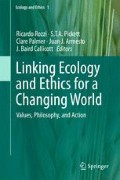Abstract
The emergence of theoretical ecology during the twentieth century advanced our understanding of what kinds of things exist in our world, such as ecological communities and ecosystems. Accordingly ecology offered a new set of things we might care about or care for, and that development has both stimulated and challenged environmental ethics. Here, I consider how ecological objects may serve as objects of moral concern. I argue that while questions remain about ecological objects, environmental ethics does not require objects more robust than those ecology already offers.
Access this chapter
Tax calculation will be finalised at checkout
Purchases are for personal use only
References
Callicott JB (1996) Do deconstructive ecology and sociobiology undermine Leopold’s land ethic? Environ Ethics 18:353–372
Callicott JB (1999) Beyond the land ethic. State University of New York Press, Albany
Clements FE (1907) Plant physiology and ecology. Henry Holt, New York
Clements FE (1916) Plant succession: an analysis of the development of vegetation. Carnegie Institution of Washington, Washington, DC
Eliot C (2007) Method and metaphysics in Clements’s and Gleason’s ecological explanations. Stud Hist Philos Biol Biomed Sci 38(1):85–109
Eliot C (2011) The legend of order and chaos: communities and early community ecology. In: deLaplante K, Brown B, Peacock K (eds) Philosophy of ecology. Elsevier, Amsterdam, pp 49–108
Gleason HA (1936a) Is the synusia an association? Ecology 17(3):444–451
Gleason HA (1936b) Twenty-five years of ecology, 1910–1935. Brooklyn Bot Gard Mem 4:41–49
Goodpaster KE (1978) On being morally considerable. J Philos 75(6):308–325
Hagen JB (1988) Organism and environment: Frederic Clements’s vision of a unified physiological ecology. In: Rainger R, Benson KR, Maienschein J (eds) The American development of biology. Rutgers University Press, New Brunswick
Isenberg AC (2001) The destruction of the bison: an environmental history, 1750–1920. Cambridge University Press, Cambridge
Lockwood JA (2011) The ontology of biological groups: do grasshoppers form assemblages, communities, guilds, populations, or something else? Psyche, pp 1–9
Mikkelson GM (2004) Biological diversity, ecological stability, and downward causation. In: Oksanen M, Pietarinen J (eds) Philosophy and biodiversity. Cambridge University Press, New York, pp 119–132
Mitchell SD (2009) Unsimple truths: science, complexity, and policy. University of Chicago Press, Chicago
Nicolson M (1990) Henry A. Gleason and the individualistic hypothesis: the structure of a botanist’s career. Bot Rev 56:97–161
Odenbaugh J (2007) Seeing the forest and the trees: realism about communities and ecosystems. Philos Sci 74(5):628–641
Sterelny K (2006) Local ecological communities. Philos Sci 73:215–231
Sutter PS (2002) Driven wild: how the fight against automobiles launched the modern wilderness movement. University of Washington Press, Seattle
Tobey R (1981) Saving the prairies: the life cycle of the founding school of American plant ecology, 1895–1955. University of California Press, Berkeley
Worster D (1990) The ecology of order and chaos. Environ Hist Rev 14:1–18
Author information
Authors and Affiliations
Corresponding author
Editor information
Editors and Affiliations
Rights and permissions
Copyright information
© 2013 Springer Science+Business Media Dordrecht
About this chapter
Cite this chapter
Eliot, C.H. (2013). Ecological Objects for Environmental Ethics. In: Rozzi, R., Pickett, S., Palmer, C., Armesto, J., Callicott, J. (eds) Linking Ecology and Ethics for a Changing World. Ecology and Ethics, vol 1. Springer, Dordrecht. https://doi.org/10.1007/978-94-007-7470-4_18
Download citation
DOI: https://doi.org/10.1007/978-94-007-7470-4_18
Published:
Publisher Name: Springer, Dordrecht
Print ISBN: 978-94-007-7469-8
Online ISBN: 978-94-007-7470-4
eBook Packages: Biomedical and Life SciencesBiomedical and Life Sciences (R0)

